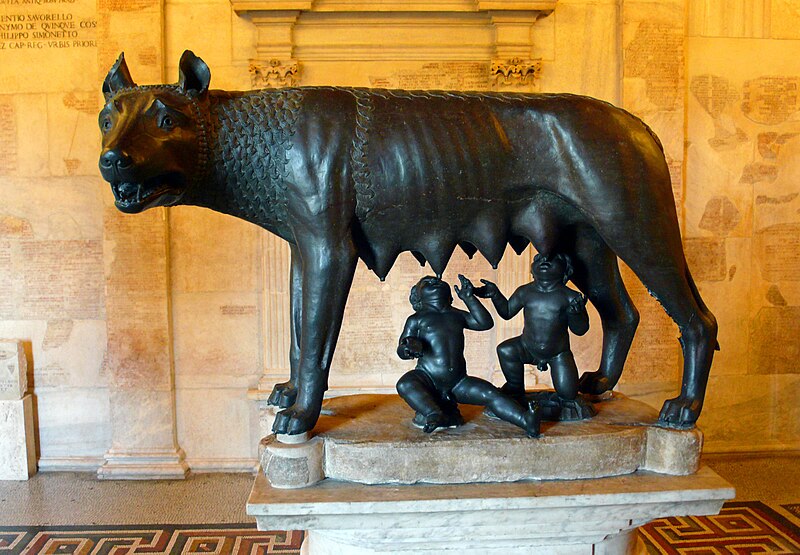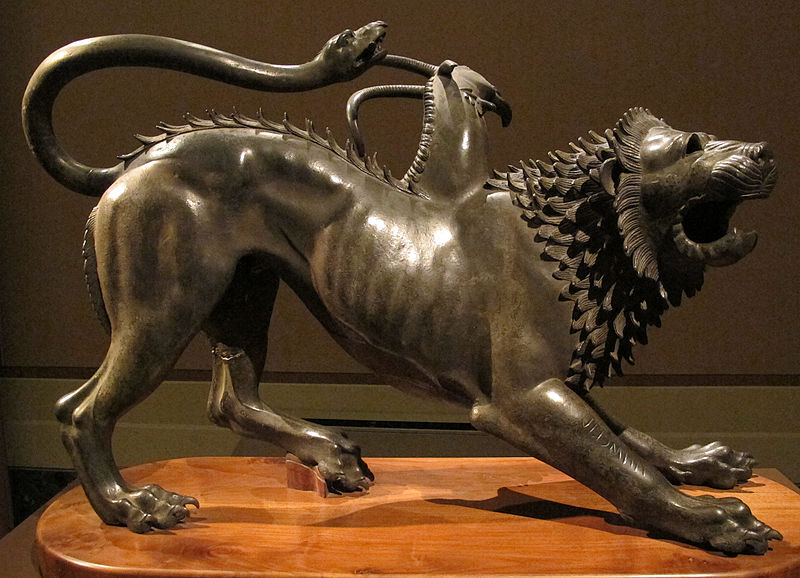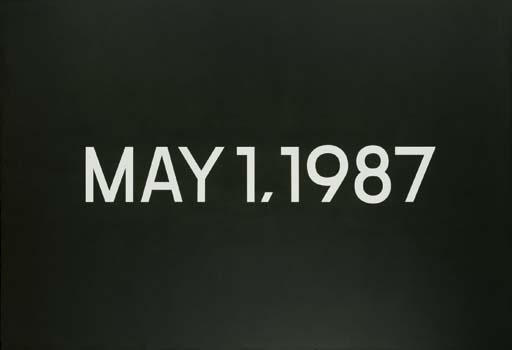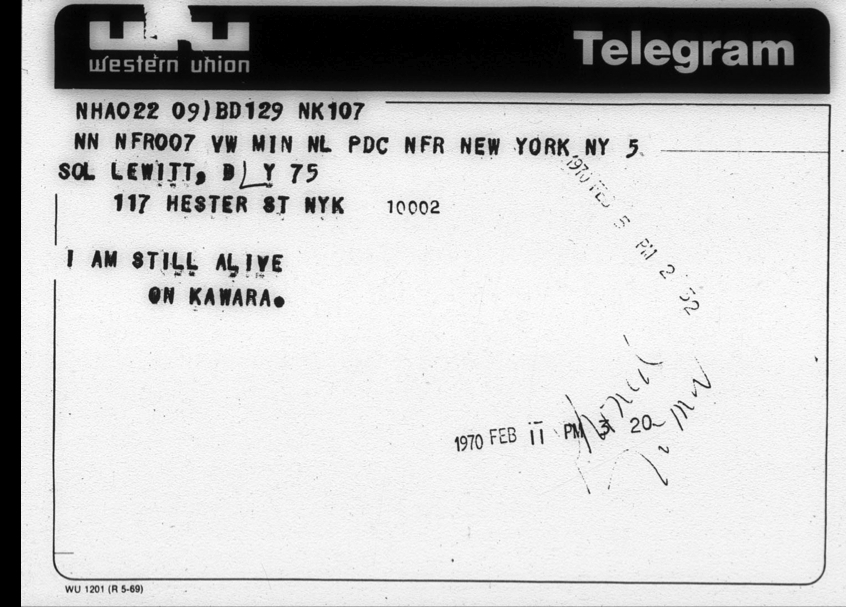My first introductions to art and art history included the Renaissance and ancient Greek and Roman works. There were plenty of books on these topics in my house and, although they were pretty boring to read as a kid, the pictures were great. I could've looked at the pictures all day long. I think I did, too.
I don't recall when I first saw the Capitoline Wolf, but it wasn't in one of those earliest art-discovering experiences. I'd seen the Discobolos and Venus de Milo a thousand times before ever encountering it. I'd learned a handful of ancient Egyptian gods and wondered at Greek black figure and red figure pottery. I knew the story of Romulus and Remus before ever seeing the statue that celebrates their infancy.
I was probably 12 or so when I first did see the sculpture labeled as ancient Roman (supposedly, from around 500 BC). It struck me as odd compared to everything I'd seen before. Maybe it was the surprised look on the wolf's face, or the clunky pose, with its back completely strait from head to hindquarters. Or maybe it was the far more fleshy and lively babies below, who certainly looked like the product of a different hand. I couldn't have put any of these things into words at the time, but somehow the sculpture just didn't fit, either with itself or with any other art I knew.
So when I read something a few weeks ago purporting that the sculpture is really a Romanesque/Renaissance creation, I was surprised at first. Then, it made a lot more sense. Evidently science has dated the Romulus and Remus figures to the late 1400s (don't they look like chubby Renaissance cherubs?). And, though results haven't come back concerning the wolf, a study of stylistic cues suggests she belongs to the Romanesque period.
The original presumption that the Capitoline Wolf was an Early Roman or Etruscan work was based on visual similarities, such as the presentation of the fur, with authentic Etruscan works like the famed Chimera of Arezzo (from 400 BC).
 The Capitoline Wolf, 480-500 BC. Or, 1200s and 1400s.
The Capitoline Wolf, 480-500 BC. Or, 1200s and 1400s.
 The Chimera of Arezzo, 400 BC. (Tail is an 18th century restoration.)
With just these two examples to look at, similarities do stand out. It's hard to imagine that one doesn't derive from the other in some way. But, take a look at this Romanesque lion and compare all three:
The Chimera of Arezzo, 400 BC. (Tail is an 18th century restoration.)
With just these two examples to look at, similarities do stand out. It's hard to imagine that one doesn't derive from the other in some way. But, take a look at this Romanesque lion and compare all three:
 Lion, Mainz Cathedral, Germany, Romanesque
To me it's interesting that the Mainz lion's face has so much in common with the Chimera's--the lines on the snout and the jowly mouth, for instance. Although the rest of the anatomy is decidedly different--look at the paws, or the blocks of muscle on the Mainz lion that are much smoother and more contoured on the Chimera. Look at the mane, flattened down on the Mainz lion and standing out at all angles on the Chimera. And the pose: the Chimera matches up with what we expect of art in the Early Roman period in that it's dynamic and expressive, while the Mainz lion is quite Romanesque in deportment. Solid, staid, and stately.
Put between these two lions, where does the Capitoline Wolf fit? It's easy to see more visual similarities to the Mainz lion--the stiffly shaped muscles, solid pose, and flat, curly mane are all comparable. And though I don't know a lot about bronze casting technology from either of these time periods, I would have to say that not only the aesthetic preferences of the time periods are evident, but also the abilities of the medium. Clearly the creator of the Chimera had a level of bronze-working technology that didn't exist in the Romanesque period, to pick out the bristling mane and veins bulging on the body and legs. These sorts of details are often seen in Roman sculpture, and I can't think of a single Romanesque sculpture with them.
If I had all the time in the world I'd delve deeper into this topic and learn everything there is to know--as it is, I don't. And yet, it just so happens that I'm signed up for a Romanesque Art History class for Fall term, starting next week. Looks like I already have a topic for my final paper!
Lion, Mainz Cathedral, Germany, Romanesque
To me it's interesting that the Mainz lion's face has so much in common with the Chimera's--the lines on the snout and the jowly mouth, for instance. Although the rest of the anatomy is decidedly different--look at the paws, or the blocks of muscle on the Mainz lion that are much smoother and more contoured on the Chimera. Look at the mane, flattened down on the Mainz lion and standing out at all angles on the Chimera. And the pose: the Chimera matches up with what we expect of art in the Early Roman period in that it's dynamic and expressive, while the Mainz lion is quite Romanesque in deportment. Solid, staid, and stately.
Put between these two lions, where does the Capitoline Wolf fit? It's easy to see more visual similarities to the Mainz lion--the stiffly shaped muscles, solid pose, and flat, curly mane are all comparable. And though I don't know a lot about bronze casting technology from either of these time periods, I would have to say that not only the aesthetic preferences of the time periods are evident, but also the abilities of the medium. Clearly the creator of the Chimera had a level of bronze-working technology that didn't exist in the Romanesque period, to pick out the bristling mane and veins bulging on the body and legs. These sorts of details are often seen in Roman sculpture, and I can't think of a single Romanesque sculpture with them.
If I had all the time in the world I'd delve deeper into this topic and learn everything there is to know--as it is, I don't. And yet, it just so happens that I'm signed up for a Romanesque Art History class for Fall term, starting next week. Looks like I already have a topic for my final paper!
I haven't got around to writing a blog for a couple of weeks but don't worry, this doesn't mean I've forgotten! Similarly, my refusal to emerge from my room doesn't mean I've stopped existing--just that I haven't got around to getting out, either.
In an effort to express this to other people I live with (but who function on totally different hours), I wrote a note the other day giving all the pertinent basics: I Am Still Alive, my name, the date, and the time I woke up. Although daily usage of the coffee pot is also a pretty good indicator that I continue to function normally.
Upon explaining the inspiration for my note (a conceptual art project by On Kawara), I was met with the question, "That's art? Who pays for it?"
My off-the-cuff answer: "Probably no one." You don't necessarily make lots of money as an artist these days--especially if your art is conceptual. Or so I thought! Then I did a little additional research on Kawara and discovered that one of his paintings sold in 2007 for almost 2 million dollars! Here's the piece:
 If you're not familiar with Kawara, you may be scratching your head. What's up with this? It looks like printed text, I could do that with my computer and one sheet of paper. Well, if I could figure out how to print white on black.
This painting is part of Kawara's best known project, the Today series. In 1966 he began creating "date paintings" from start to finish, each one within the day it commemorated. He doesn't paint them every single day; however, if a date painting is not finished by the end of the day, he destroys it. He's still making them, almost 50 years into the project. This persistence is pretty impressive to me--I can't imagine being interested in any of the same things 50 years from now, much less being so dedicated to them. My husband, who's a realistic painter, appreciates Kawara's ability to paint those perfectly precise characters freehand, no stencils included.
But when I first encountered Kawara in Contemporary Art, I was most intrigued by his telegrams and postcards. For a while he sent telegrams (upon which my note was based) informing friends that "I am still alive," like this:
If you're not familiar with Kawara, you may be scratching your head. What's up with this? It looks like printed text, I could do that with my computer and one sheet of paper. Well, if I could figure out how to print white on black.
This painting is part of Kawara's best known project, the Today series. In 1966 he began creating "date paintings" from start to finish, each one within the day it commemorated. He doesn't paint them every single day; however, if a date painting is not finished by the end of the day, he destroys it. He's still making them, almost 50 years into the project. This persistence is pretty impressive to me--I can't imagine being interested in any of the same things 50 years from now, much less being so dedicated to them. My husband, who's a realistic painter, appreciates Kawara's ability to paint those perfectly precise characters freehand, no stencils included.
But when I first encountered Kawara in Contemporary Art, I was most intrigued by his telegrams and postcards. For a while he sent telegrams (upon which my note was based) informing friends that "I am still alive," like this:

This one's to the famous Minimalist Sol LeWitt!
Or, he would send postcards declaring "I got up at ..." and give the time of morning.

(I picked an example that makes him look like an early riser.)
It's notable that both of these works affirm the continuing existence of the artist in a manner that is impersonal. His handwriting isn't on them so how can you be sure they're by Kawara? And if their authorship is untraceable, how can you be sure he still exists? Maybe he doesn't, and the whole premise is a sham!
Also tied into their impersonal nature, there is no sentimentality in Kawara's conception of existence. Existing is just a state of being, a scientific fact. He could just as easily send telegrams stating: Gravity Still Works. This would be concerned with the existence of the world as we know it, but I suspect that to him the fact of existing is just one more quantifiable scientific phenomena.
Obviously, as this is conceptual art, the nuance is in the idea, not the product. The telegram or postcard is a vehicle for the artist's message. Don't ask me precisely what that message is, as I am only tangentially familiar with his work, but judging from the three examples above, Kawara's main concerns are with human existence in time. Time, not space. I watched a video earlier today where the presenter said something like, "If you're not doing anything with your time, then you're just getting older." And, since I'd already been thinking about Kawara recently (and planning to write this blog! Honestly!) this statement brought me back to the realm of conceptual existentialism. Is the issue of Kawara's impersonal messages the only existential factor at play, or are there others?
For example, if Kawara doesn't send a telegram to Sol LeWitt letting him know that he's still alive, then does LeWitt even think about Kawara's existence? Only by sending these messages to others does he keep himself in their awareness. And, maybe, it's only by asserting his continuing existence to others that Kawara actually does continue to exist, or at least validate the fact. Sending a postcard concerning the time you woke up is just another way of saying a quite similar thing: I am still present in the waking world. Wherever I may have been when I was asleep, I'm back now.
And by receiving one of these messages, your own existence is affirmed, too, isn't it? If Kawara sent a message to you, and you got it, then you must be alive too. Or awake. You are both functioning on the same plane of consciousness. There is no personal interaction here--you can't even recognize an old friend's handwriting in the message--but something deeper, more profound. A two-way affirmation of continuing existence, humanity, cognizance, what have you. I don't know Kawara's philosophy of life and didn't want to study it before writing this or surely my own observations would be tempered.
But if you know me you know I have to tie this blog back around to the beginning, and where did we start? With May 1, 1987. I expressed surprise that this painting--one date among thousands that Kawara has painted--made almost 2 million dollars at auction. But keep in mind that this painting was 20 years old when it sold for that price. So, although conceptual art makes itself difficult to sell by existing in ideas and not in objects, a date painting with twenty years of history on it has, I guess, picked up a peculiar sort of sentimentality, too. At least I'd prefer to think it's this.
Because how can you put a price tag on assertions of human existence? It's not that I think Kawara's ideas have no value, but that their ultimate ideas exceed the assignation of worth. Which makes it comforting, then, to know that even if someone buys one of his telegrams or postcards, they actually aren't buying the work of art but only physical evidence of it. Because you can't buy human interaction or existential affirmation.
Or can you?





